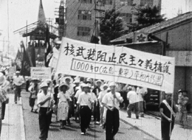Fluttering Pigeons
(“Hato wa habataku”) 1958 / B&W / 16mm / 42 min
1958 / B&W / 16mm / 42 min
Photography, Editing, Sound, Source: Japan Document Film
Planning: Japan Council against A & H Bombs
A record of the Fourth World Conference against A & H Bombs. On June 20,1958, peace demonstrators for the prevention of atomic weapons and the protection of democracy embarked upon a 1,000 km walk from Hiroshima Peace Park to Tokyo. Only one person initially participated in the demonstration, but the number increased to two in Hiroshima, then four in Okayama and gradually increased further. A welcome party was held during Kyoto’s Gion Festival and also in front of Kyoto City Hall. Adherents of the Omoto-kyo religion participated in Otsu. The demonstration went to Nagoya after Hikone and Gifu, eventually numbering 2,000 people, and students from Osaka Municipal School for the Blind joined during their summer holiday. It visited a grave for the victims of the Daigo Fukuryu Maru tragedy in Yaizu City, Shizuoka Prefecture. A group of cyclists from Aomori headed for Tokyo. The demonstration encountered some difficulty with policemen after Sunagawa but managed to progress safely. Priests from the Tokyo Buddhism Association attended. 53 days after leaving Hiroshima, one million people had walked together and 2,000 people applauded as walkers entered Tokyo’s Hibiya Park. On August 12 the Fourth World Conference against A & H Bombs opened; an all-Japan Conference was held on the first day, subcommittee meetings on the second day, and classified meetings on the third. The declaration was read in public at the General Domestic Conference on August 15. An International Conference was held on the 16th and, having passed subcommittee and classified meetings, the declaration was adopted at the international conference’s general meeting on the 20th. Laborers battling to prevent the importation by the Self-Defense Agency of Japan of surface to air guided missiles from Switzerland also took part.
Representatives of the various countries attending presented Thousand Crane origami chains and prayed for peace, then the General Conference ended. The declaration was presented at Hibiya Music Hall in the hope of preventing the further proliferation of nuclear weapons. This was Kusunoki Tokuo’s first film succeeding Teshigahara Hiroshi as a member of the crew.
